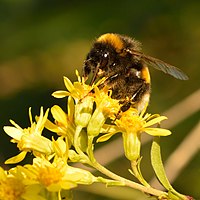
Characterization of the complete sequence analysis of mitochondrial DNA of Japanese rare bumblebee species Bombus cryptarum florilegus
Sign Up to like & getrecommendations! Published in 2017 at "Conservation Genetics Resources"
DOI: 10.1007/s12686-017-0832-z
Abstract: The bumblebee (genus Bombus) distributed in the Northern Hemisphere is mostly decreasing and is extinct in some populations on several species within the last half century. The bumblebee Bombus cryptarum florilegus is designated as a… read more here.
Keywords: bombus cryptarum; cryptarum; cryptarum florilegus; mitochondrial dna ... See more keywords

Mitochondrial DNA intra-individual variation in a bumblebee species: a challenge for evolutionary studies and molecular identification.
Sign Up to like & getrecommendations! Published in 2020 at "Mitochondrion"
DOI: 10.1016/j.mito.2020.06.007
Abstract: Mitochondrial DNA (mtDNA) regions have been widely used as molecular markers in evolutionary studies and species identification. However, the presence of heteroplasmy and NUMTs may represent obstacles. Heteroplasmy is a state where an organism has… read more here.
Keywords: variation; evolutionary studies; dna; intra individual ... See more keywords

Nicotine in floral nectar pharmacologically influences bumblebee learning of floral features
Sign Up to like & getrecommendations! Published in 2017 at "Scientific Reports"
DOI: 10.1038/s41598-017-01980-1
Abstract: Many plants defend themselves against herbivores by chemical deterrents in their tissues and the presence of such substances in floral nectar means that pollinators often encounter them when foraging. The effect of such substances on… read more here.
Keywords: floral nectar; nicotine floral; nectar; pharmacologically influences ... See more keywords

Ovary activation does not correlate with pollen and nectar foraging specialization in the bumblebee Bombus impatiens
Sign Up to like & getrecommendations! Published in 2018 at "PeerJ"
DOI: 10.7717/peerj.4415
Abstract: Social insect foragers may specialize on certain resource types. Specialization on pollen or nectar among honeybee foragers is hypothesized to result from associations between reproductive physiology and sensory tuning that evolved in ancestral solitary bees… read more here.
Keywords: nectar; specialization; pollen nectar; ovary activation ... See more keywords